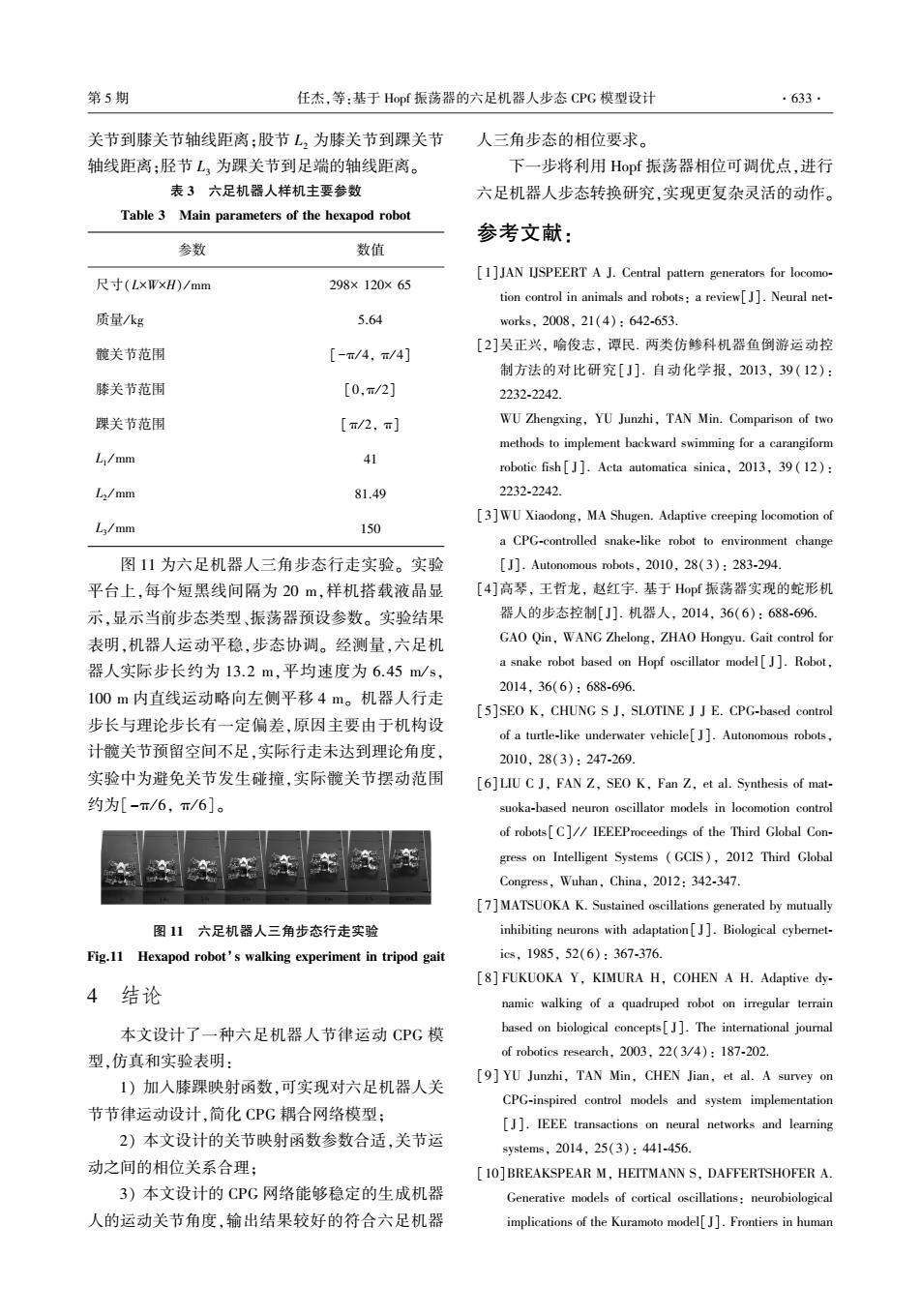正在加载图片...

第5期 任杰,等:基于Hopf振荡器的六足机器人步态CPG模型设计 .633. 关节到膝关节轴线距离:股节L,为膝关节到踝关节 人三角步态的相位要求。 轴线距离:胫节L3为踝关节到足端的轴线距离。 下一步将利用Hopf振荡器相位可调优点,进行 表3六足机器人样机主要参数 六足机器人步态转换研究,实现更复杂灵活的动作。 Table 3 Main parameters of the hexapod robot 参考文献: 参数 数值 [1]JAN IJSPEERT A J.Central pattern generators for locomo- 尺寸(L×WxH)/mm 298×120×65 tion control in animals and robots:a review[J].Neural net- 质量/kg 5.64 works,2008.21(4):642-653. 髋关节范围 [2]吴正兴,喻俊志,谭民.两类仿鲹科机器鱼倒游运动控 [-π/4.π/4] 制方法的对比研究[J].自动化学报,2013,39(12): 膝关节范围 [0./2] 2232-2242. 踝关节范围 [π/2,m] WU Zhengxing,YU Junzhi,TAN Min.Comparison of two methods to implement backward swimming for a carangiform L/mm 41 robotic fish[J].Acta automatica sinica,2013,39(12): L/mm 81.49 2232-2242. [3]WU Xiaodong,MA Shugen.Adaptive creeping locomotion of L/mm 150 a CPG-controlled snake-like robot to environment change 图11为六足机器人三角步态行走实验。实验 J].Autonomous robots,2010,28(3):283-294 平台上,每个短黑线间隔为20m,样机搭载液晶显 [4]高琴,王哲龙,赵红宇.基于Hopf振荡器实现的蛇形机 示,显示当前步态类型、振荡器预设参数。实验结果 器人的步态控制[J].机器人,2014,36(6):688-696. 表明,机器人运动平稳,步态协调。经测量,六足机 GAO Qin,WANG Zhelong,ZHAO Hongyu.Gait control for 器人实际步长约为13.2m,平均速度为6.45m/s, a snake robot based on Hopf oscillator model[J].Robot, 2014,36(6):688-696. 100m内直线运动略向左侧平移4m。机器人行走 [5]SEO K,CHUNG S J,SLOTINE JJ E.CPG-based control 步长与理论步长有一定偏差,原因主要由于机构设 of a turtle-like underwater vehicle[]]Autonomous robots, 计髋关节预留空间不足,实际行走未达到理论角度, 2010,28(3):247-269. 实验中为避免关节发生碰撞,实际髋关节摆动范围 [6]LIU C J,FAN Z,SEO K,Fan Z,et al.Synthesis of mat- 约为[-/6,π/6]。 suoka-based neuron oscillator models in locomotion control of robots[C]//IEEEProceedings of the Third Global Con- gress on Intelligent Systems (GCIS),2012 Third Global Congress,Wuhan,China,2012:342-347. [7]MATSUOKA K.Sustained oscillations generated by mutually 图11六足机器人三角步态行走实验 inhibiting neurons with adaptation[].Biological cybernet- Fig.11 Hexapod robot's walking experiment in tripod gait ics,1985,52(6):367-376. [8]FUKUOKA Y.KIMURA H.COHEN A H.Adaptive dy- 4结论 namic walking of a quadruped robot on irregular terrain 本文设计了一种六足机器人节律运动CPG模 based on biological concepts[J].The international journal 型,仿真和实验表明: of robotics research,2003,22(3/4):187-202. 1)加入膝踝映射函数,可实现对六足机器人关 [9]YU Junzhi,TAN Min,CHEN Jian,et al.A survey on CPG-inspired control models and system implementation 节节律运动设计,简化CPG耦合网络模型: [J].IEEE transactions on neural networks and learning 2)本文设计的关节映射函数参数合适,关节运 systems,2014,25(3):441-456. 动之间的相位关系合理: [10]BREAKSPEAR M,HEITMANN S,DAFFERTSHOFER A. 3)本文设计的CPG网络能够稳定的生成机器 Generative models of cortical oscillations:neurobiological 人的运动关节角度,输出结果较好的符合六足机器 implications of the Kuramoto model[J].Frontiers in human关节到膝关节轴线距离;股节 L2 为膝关节到踝关节 轴线距离;胫节 L3 为踝关节到足端的轴线距离。 表 3 六足机器人样机主要参数 Table 3 Main parameters of the hexapod robot 参数 数值 尺寸(L×W×H) / mm 298× 120× 65 质量/ kg 5.64 髋关节范围 [-π/ 4, π/ 4] 膝关节范围 [0,π/ 2] 踝关节范围 [π/ 2, π] L1 / mm 41 L2 / mm 81.49 L3 / mm 150 图 11 为六足机器人三角步态行走实验。 实验 平台上,每个短黑线间隔为 20 m,样机搭载液晶显 示,显示当前步态类型、振荡器预设参数。 实验结果 表明,机器人运动平稳,步态协调。 经测量,六足机 器人实际步长约为 13.2 m,平均速度为 6.45 m / s, 100 m 内直线运动略向左侧平移 4 m。 机器人行走 步长与理论步长有一定偏差,原因主要由于机构设 计髋关节预留空间不足,实际行走未达到理论角度, 实验中为避免关节发生碰撞,实际髋关节摆动范围 约为[-π/ 6, π/ 6]。 图 11 六足机器人三角步态行走实验 Fig.11 Hexapod robot’s walking experiment in tripod gait 4 结论 本文设计了一种六足机器人节律运动 CPG 模 型,仿真和实验表明: 1) 加入膝踝映射函数,可实现对六足机器人关 节节律运动设计,简化 CPG 耦合网络模型; 2) 本文设计的关节映射函数参数合适,关节运 动之间的相位关系合理; 3) 本文设计的 CPG 网络能够稳定的生成机器 人的运动关节角度,输出结果较好的符合六足机器 人三角步态的相位要求。 下一步将利用 Hopf 振荡器相位可调优点,进行 六足机器人步态转换研究,实现更复杂灵活的动作。 参考文献: [1]JAN IJSPEERT A J. Central pattern generators for locomo⁃ tion control in animals and robots: a review[J]. Neural net⁃ works, 2008, 21(4): 642⁃653. [2]吴正兴, 喻俊志, 谭民. 两类仿鲹科机器鱼倒游运动控 制方法的对比研究[ J]. 自动化学报, 2013, 39 ( 12): 2232⁃2242. WU Zhengxing, YU Junzhi, TAN Min. Comparison of two methods to implement backward swimming for a carangiform robotic fish [ J]. Acta automatica sinica, 2013, 39 ( 12): 2232⁃2242. [3]WU Xiaodong, MA Shugen. Adaptive creeping locomotion of a CPG⁃controlled snake⁃like robot to environment change [J]. Autonomous robots, 2010, 28(3): 283⁃294. [4]高琴, 王哲龙, 赵红宇. 基于 Hopf 振荡器实现的蛇形机 器人的步态控制[J]. 机器人, 2014, 36(6): 688⁃696. GAO Qin, WANG Zhelong, ZHAO Hongyu. Gait control for a snake robot based on Hopf oscillator model [ J]. Robot, 2014, 36(6): 688⁃696. [5]SEO K, CHUNG S J, SLOTINE J J E. CPG⁃based control of a turtle⁃like underwater vehicle[ J]. Autonomous robots, 2010, 28(3): 247⁃269. [6]LIU C J, FAN Z, SEO K, Fan Z, et al. Synthesis of mat⁃ suoka⁃based neuron oscillator models in locomotion control of robots[C] / / IEEEProceedings of the Third Global Con⁃ gress on Intelligent Systems ( GCIS), 2012 Third Global Congress, Wuhan, China, 2012: 342⁃347. [7]MATSUOKA K. Sustained oscillations generated by mutually inhibiting neurons with adaptation[ J]. Biological cybernet⁃ ics, 1985, 52(6): 367⁃376. [8] FUKUOKA Y, KIMURA H, COHEN A H. Adaptive dy⁃ namic walking of a quadruped robot on irregular terrain based on biological concepts[ J]. The international journal of robotics research, 2003, 22(3 / 4): 187⁃202. [9] YU Junzhi, TAN Min, CHEN Jian, et al. A survey on CPG⁃inspired control models and system implementation [J]. IEEE transactions on neural networks and learning systems, 2014, 25(3): 441⁃456. [10]BREAKSPEAR M, HEITMANN S, DAFFERTSHOFER A. Generative models of cortical oscillations: neurobiological implications of the Kuramoto model[J]. Frontiers in human 第 5 期 任杰,等:基于 Hopf 振荡器的六足机器人步态 CPG 模型设计 ·633·